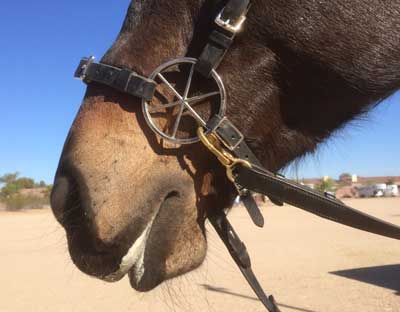With difficult, atypical horses, it is never easy to figure out how to change behavior and turn them into horses that are manageable to ride and work with. Your best chance at understanding them and changing them lies in your ability to be flexible, completely open-minded, and willing to keep trying and trying new things.
With my strong mare who tends to ask constantly to go faster and rushes on rides, I’ve tried to use a bitless option a couple of times. With either a sidepull or crossunder bitless bridle, she made it very clear she disliked the pressure by shaking her head, raising her neck and bracing or plowing through. I’ve tried different bits that are less harsh, but have always ended up back in a Kimberwicke with her. While I am a very bold rider, there is still a balance of safety for the horse, and I have a concern about my horse running unsafely or too far and injuring herself.
Just recently, I was given more information about some types of bitless bridles I had not considered. In particular, I was shown some examples of horses being galloped and jumped in hackamores that had more of an option for steering than the typical mechanical hackamore or S-hackamore.
Some of these include the LG, the Barefoot hackamore, the Flower hackamore and the Star Wheel hackamore.
LG Hackamore
Barefoot Hackamore

Flower Hackamore

Star Wheel Hackamore
Since I could readily find a Flower Hackamore online, I went ahead and ordered one to try on my mare. It came with a biothane strap under the chin, which I traded for a chain since I wanted to be sure she wouldn’t immediately take off with me.
I’ve been riding in the Flower Hackamore for several weeks now. To my surprise, this type of hackamore feels very much like riding in a snaffle, and you can raise or lower the head, lift the shoulders and give finely tuned cues that you can’t give in a sidepull or other bitless bridles I’ve tried.
Unlike a snaffle, with this type of hackamore you can use a chain in the same way you would in a Kimberwicke. This means that if the horse becomes strong and tries to put her head down and plow through the headgear, the rider can raise the head and shoulders and regain control of the horse. Between this action and the ability to use a direct rein to steer in either direction, so far I have been able to slow my mare in the bitless bridle even when she has asked to go faster.
Even though the pressure on the horse’s face is not amplified the way it is with any bit, it has so far translated into the same amount of pressure from the rider’s hand to elicit a response from the horse. Instead of concentrating all the force of the rider’s hand on the nerves covering the sensitive bones of the bars in the horse’s mouth, the hackamore spreads the pressure around the horse’s nose. I’ve concluded that the only way this works as well as it does to control the horse, is because by reducing the pain you are reducing the adrenaline and endorphin release in the horse, which takes a lot of the edge off their desire to run and keep running.
At slower speeds, my mare is much more calm in this hackamore than she was previously when wearing her Kimberwicke. She has never been calm enough to stop and graze while on a ride, and we’ve done this several times in the past couple of weeks now.
Once I started on the path of trying new things with my mare, it occurred to me that this adrenaline release due to pain might also be something to consider regarding her saddle. I’ve known for a long time that the saddle fit was not ideal, but had given up on improving the fit anymore since I’d gone to great lengths to find a saddle with a tree that would leave room for her shoulders and that fit her as well as I could find in a treed saddle. After doing some more research, I realized the only thing holding me back from trying a treeless saddle with this horse was my imagination of the saddle sliding irretrievably to one side while at a full gallop.
People online reassured me that treeless saddles have improved very much, and I also recalled that I’d seen insecure riders cause well-fitted treed saddles to slide well over to one side. Plus my current “well-fitting” saddle was constantly trying to slip to the right due to my mare’s huge, asymmetrical shoulders. My concerns about harming my horse’s back also were done away with as I thought about how my current saddle left dry marks under the stirrup bars at times, and read about the pressure distribution of the new treeless saddles.
Not wanting to take a chance with a cheap brand of treeless saddle, I found a used Freeform Classic. I could find many pictures online of people doing endurance riding and riding at faster gaits in these saddles.
A Freeform Classic
Immediately, on my first ride in the treeless saddle I could feel that my horse had freer movement. The saddle stayed straight on her back instead of sliding to one side, and I was finally, for the first time sitting over her center of gravity. Previously, in order to free her shoulders I’d had to put the saddle farther back, which made her gaits feel rough and put me behind the motion.
When I added the treeless saddle to the bitless bridle, instead of becoming more dangerous and out of control, I discovered my mare was more level-headed and reasonable. This brought me back to the lesson I’ve been learning over and over with horses: It’s always pain.
Whenever my horses have had poor attitudes, not wanted to be caught, had difficulty being girthed, felt sluggish and lazy, been spooky, or wanted to rush and push through cues; each time it has been removing a source of pain that improved my horse’s attitude.
Horses are easy to train. They are willing creatures that head for the path of least resistance. Although they have a tremendous variety of personalities among them, they still are not ever evil or malicious. They may do things we dislike out of fear or high spirits, but the more we work with them, the more malleable they will be. Any horse that does not seem cooperative or seems difficult to train has pain or fear that is blocking the process. After a certain amount of time, fear resolves, but pain can keep a horse in a particular state for many months and even years.
What I’ve found is no amount of training can improve a horse as much as removing a source of pain and making the horse feel comfortable while he is working.

……and the pain may be the cause of the fear…….